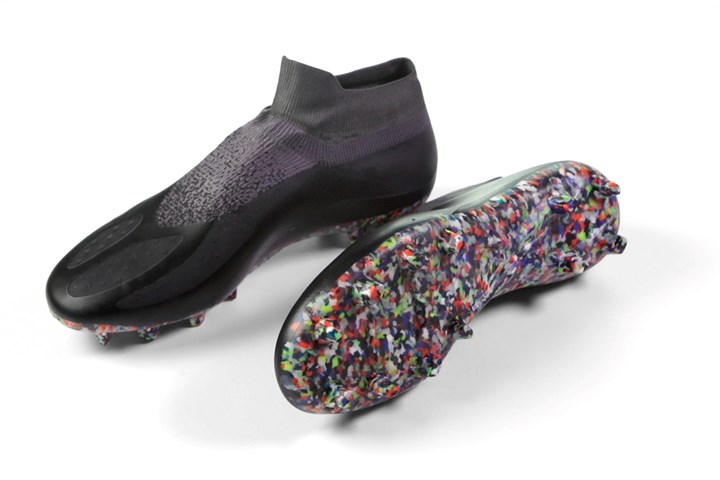
Sporting goods company Decathlon’s (Villeneuve-d'Ascq, France) soccer (football) brand Kipsta aims to spur the industry toward more recyclable solutions with the recent development of a new soccer cleat made with recycled materials.
Called the Traxium Compressor and announced in October 2021, the shoe is said to be manufactured completely from recycled thermoplastic waste derived from end-of-life (EOL) sporting goods like plastic balls or shoes. The waste is shredded and repurposed as both fibrous yarns and a resin matrix, and formed in a single-step molding process developed by sustainable solutions company Demgy (Saint-Aubin-sur-Gaillon, France).
ADEME, the French Environment and Energy Management Agency (Angers, France), is supporting the project by collecting, sorting and processing EOL products for reuse as Traxium shoes. According to Ophélie Westphal, research and development manager at Demgy Atlantique, one goal behind the materials decision was to reduce the number of materials sourced for use within the shoe, to further facilitate recycling at the Traxium Compressor’s EOL.

In the patented design, the laminate thickness varies along the shoe, with foam reinforcement where needed. Ophélie Westphal says the way the materials are layered is “totally new: Decathlon has played with the percent of resin and the fiber architecture [fiber orientation and textile mesh architecture] to give flexibility or rigidity to the different areas of the shoe.” The design combines the upper part of the shoe and sole into one shape without glue, to eliminate issues with shoe delamination over time.
During the design process, as the Demgy and Kipsta teams strove to attain the optimal shape, thickness and material composition, iterations of the shoe were tested by professional soccer players.
To manufacture the shoe, prefabricated thermoplastic composite preforms are layered into specially designed tools, and consolidated via heat and pressure in a single-step closed molding process. During the lamination process, inserts for the cleats are placed between some of the plies before the mold is closed. The mold is heated by conduction and cooled by water circulation until the shoe is cool enough to demold. Demgy designed and manufactured the tools (one tool per available shoe size) using designs provided by Kipsta/Decathlon.
According to Westphal, the key is a combination of “revolutionary mold design with an innovative process with composite preforms.” The Traxium Compressor is said to be a completely net-shape product with no post-processing steps needed.
Related Content
-
Composite materials, design enable challenging Corvette exterior components
General Motors and partners Premix-Hadlock and Albar cite creative engineering and a move toward pigmented sheet molding compound (SMC) to produce cosmetic components that met strict thermal requirements.
-
Composite wrap system combats corrosion in industrial tank repair
A fiberglass and carbon fiber composite wrap system enabled an Australian nickel mine to quickly repair a stainless steel ammonium sulphate feed tank and protect against future corrosion.
-
Carbon fiber satellite arm reduces weight, simplifies assembly onto naval vessels
Satcom developer EM Solutions partnered with ACS Australia to replace an aluminum arm design with a 65% lighter, one-piece, corrosion-resistant carbon fiber/epoxy alternative.


.jpg;width=70;height=70;mode=crop)






.jpg)








